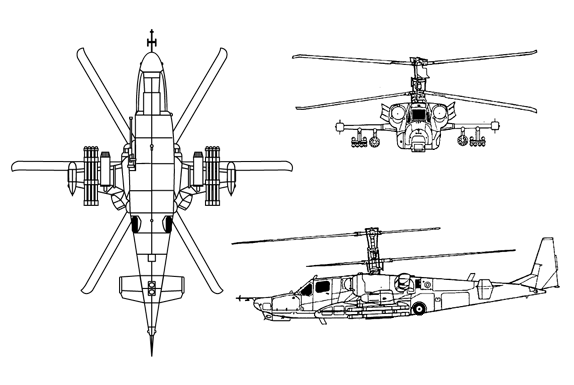
Ka-52
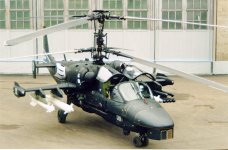
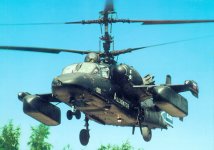
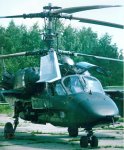
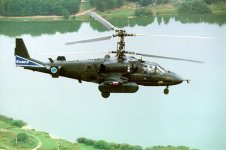




External stores are mounted on underwing external hardpoints. Each wing has two hardpoints for a total of four stations. A typical mix for targeting armor formations is 12x AT-16 ATGMs, 500x 30-mm cannon rounds, and 2x 20-round pods of 80-mm folding fin unguided rockets. The 30-mm cannon is the same as on the BMP-2. It also carries guided air-to-air missiles IGLA-V (Needle C), already extensively tested and sold to buyers abroad. The Shark's avionics is largely in line with what is the norm for one-seater fighters and ground attack jets. It's most remarkable feature is a remote targeting system with a capability to provide for a sudden deadly attack from a distance that rules out direct visual contact with the target. The firing computer will turn the aircraft to keep the gun on target. It is equipped with downlink to provide information from the battlefield. The targeting and control system and weaponry enable accurate target engagement at ranges of up to 10km.
The KA-50 features unique maneuvrability and operating characteristics due to the contra-rotating co-axial rotors. The coaxial counter-rotating rotor system negates the need for a tail rotor and its drive system. Because of this, this aircraft is unaffected by wind strength and direction, has an unlimited hovering turn rate, and gives a smaller profile and acoustic signature, while allowing a 10-15% greater power margin. The HOKUM is fully aerobatic. It can perform loops, roll, and �the funnel�, where the aircraft will maintain a concentrated point of fire while flying circles of varying altitude, elevation, and airspeed around the target.Beginning in 1997 Kamov company, in partnership with IAI, began competing in the tender for a $4 billion contract for the supply of 145 combat helicopters to the Turkish Army. In compliance with the tender requirements, KAMOV/IAI group submitted the required documentation on the Ka-50-2 Erdogan tandem twin-sitter in November 1999. On 06 March 2000, Bulent Ecevit, the Prime Minister of Turkey, announced that Boeing and Eurocopter, French/German company, would be excluded from the list of the Bidders for the combat helicopters supply contract. Among the remaining competitors for the contract award are KAMOV/IAI (Israel Aircraft Industries Ltd.) group with its Ka-50-2 Erdogan, Agusta company from Italy with its A129 Mongoose and Belltextron company from the USA with its AH-1Z King Cobra.
Specifications | |
| Country of Origin | Russia |
| Builder | KAMOV |
| Role | Antihelicopter and gunship |
| Similar Aircraft | Hirundo A109, Mangusta A129, AH-64 Apache, AH-1F Cobra |
| Blades | Main rotor: 6 (2 heads, 3 blades each) Tail rotor: None |
| Rotor diameter | 14.5 meters |
| Wing span | 7.34 meters |
| Length |
rotors turning: 16 meters fuselage: 15.0 meters |
| Height |
gear extended: 4.93 meters gear retracted: 4 meters |
| Cargo Compartment Dimensions | Negligible |
| Engines | 2x 2,200-shp Klimov TV3-117VK turboshaft |
| Weight |
Maximum Gross: 10,800 kg Normal Takeoff: 9,800 kg Empty: 7,692 kg |
| Standard Payload | External weapons load: 2,500 kg on 4 under-wing stores points. |
| Speed |
Maximum (level): 340 km/h (est.) Cruise: 270-310 km/h Sideward: 100+ km/h, Rearward: 100+ km/h |
| Turn Rate | unlimited |
| Max �G� Force | +3 to +3.5 g |
| Ceiling |
Service: 5,500 meters Hover (out of ground effect): 4,000 meters Hover (in ground effect): 5,500 meters |
| Vertical Climb Rate | 10 m/s |
| Fuel (liters) |
Internal: INA External Fuel Tank: 500 ea. (max 4x) |
| Range (km) |
Maximum Load: INA Normal Load: 460 With Aux Fuel: INA |
| Armament |
Range: effective 3,000 m Elevation: -45� to +10� Traverse: �15� Ammo type and rate of fire is selectable by pilot (HE or AP, 350 or 600) Most Probable Armament: |
| AVIONICS |
|
| Survivability/Countermeasures |
|
| Crew | 1 (pilots, 2 in Ka-52) |
| Cost | |
| User Countries | Preproduction in Russia. An initial fielding plan is for 2 per year for 14 years. |




